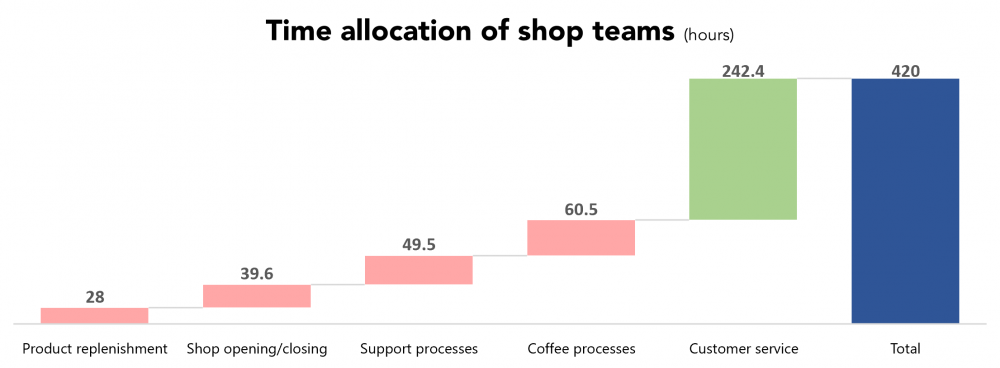The company
Premium producer and retailer of chocolate and complementary products and a market leader with a vision for international expansion. It has a network of more than 140 shops in 3 countries. The company’s strategy focuses on providing a luxury experience to each customer, both through the service provided in-store and through the quality of the products sold.
The challenge
With the growth of e-commerce, consumers have become more demanding when it comes to in-store shopping experiences as it’s expected that the physical traveling to a point of sale is rewarded with a rich, sensorial, and complete experience. Not only must the physical space be inviting, but also the teams present on-site must have the necessary knowledge to advise on the products best suited to the customer’s requirements.
To meet this market demand, a project team was challenged to improve shop processes, eliminate non-value added tasks and maximise team skills, leading to better service and greater customer satisfaction.
The approach
Current situation analysis
To overcome the challenge, the team began by surveying and observing all the activities performed by the shop teams. It was found that 42% of the time when the shop was open, the teams were unavailable for customer service, and dedicated to support activities instead. This situation was further compounded by the administrative burden borne by the shop manager, which made it impossible for him to actively manage priorities during the day.

Teams occupied their time in an unstructured way, carrying out support tasks at ad-hoc times, without any action trigger. The frequency and correct timing for each activity was not clear. The teams’ focus was on ensuring their continued occupation, and not on being available for any customer that might come into the shop.
The identification of processes also made it possible to understand that the tasks varied between shops and were implemented locally by each team independently. Many of these tasks did not add any value to the customer, and also reduced the teams’ availability.
The expected behaviour when approaching each customer included the following: 1) welcoming 2) sample offer 3) interaction 4) buying 5) upselling. Based on the observation of 58 customer journeys, the offer of a product sample was made in 59% of the cases and was complemented with an interaction with the customer in only 19% of the cases. As a result, only 50% of the customers’ visits resulted in a sale, with only 24% of these taking advantage of the opportunity to upsell.
Solution design
Once the main opportunities for improving customer service had been identified and the team focused on designing solutions. The solutions were tested in 6 pilot shops of different formats, and after validation of the intended result, they were implemented in all the shops. This was made possible through the TDP – Team Development Programme, which ensures the lean training and development of a large number of teams in a short period of time.
The transformation process started by training the teams in KAIZEN™ foundations. By breaking the paradigms associated with the operation, the teams became autonomous in identifying improvement opportunities and eliminating tasks with no added value. The teams were challenged to look at their processes, detailing how they could be optimised. Being able to ‘talk with data’, i.e. quantify the opportunities and benefits, was something that marked the cultural change in shop teams. The customer-focused culture and shopping experience was extended to all shops.
This was followed by the improvement of shop management processes, with the description of the manager’s role outlined, both in terms of competencies and responsibilities. Work standards have also been defined which detail the tasks to be performed by this role at each moment of the day.
Prior to the definition of the standard, all tasks were analysed, those that were not necessary were eliminated, and the remaining were automated whenever possible. For the larger shops, the role of the concierge was also defined, who is responsible for ensuring the support tasks and assisting the shop team in case the shop manager is absent.
With regards to teamwork planning, a daily routine has been established in which the sales objective for the day and the allocation of tasks to each employee at any given moment of the day are communicated. In this team briefing, discussions occur about how the previous day went, if there were any difficulties, and improvement actions are defined to avoid their recurrence. This is also where staff training in customer service skills, product knowledge or support activities are planned.
To guarantee the ongoing improvement of shop processes, while ensuring standardisation within the network, a system was established to share the improvements implemented. In this system, shop teams submit the improvements developed, along with the benefits obtained in their shop. Afterwards, if the improvement is applicable, the managers of the remaining shops can train their teams in the new standards designed.
Results
Overall, the implemented solutions resulted in an 82% reduction in the time spent on tasks with no added value for the client – equivalent to 35,500 hours per year. As a result, the teams have more time available to ensure a personalised service for each customer. Added to the gain of freeing up resources’ time is the increase in sales associated with a better customer experience, which is now closely monitored by shop teams empowered to support the buying journey.
#retail #operations
See more on Retail
Find out more about transformation in this sector
See more on Operations
Find out more about improving this business area
